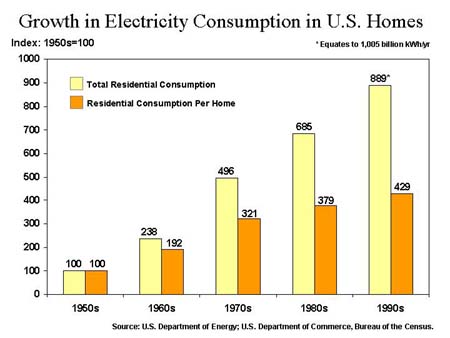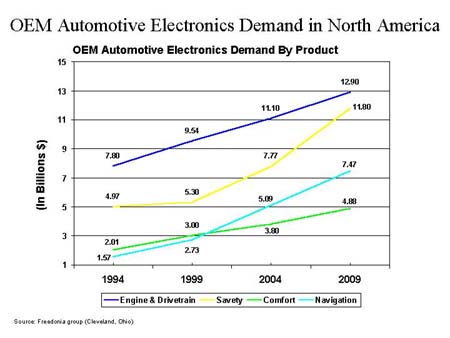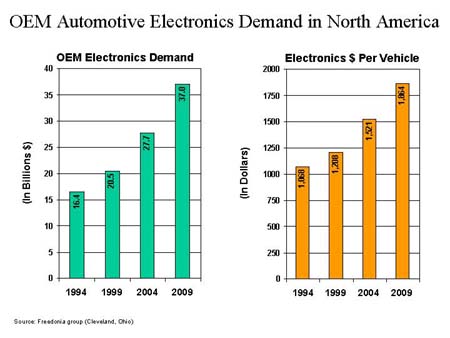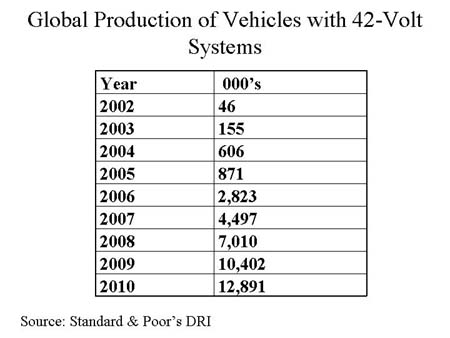This paper examines three new opportunities for copper and copper alloy products that involve the Internet, the home, and the automobile.
The Internet. The Internet Age is upon us. We live in a time when we expect communications to be instantaneous. Response times are measured in seconds. Faster, cheaper, bigger, better is society's mantra. We want the ability to download video streams on our PCs that are of the highest quality. The infrastructure necessary to make this possible is just now being put into place.
It is estimated that 117 million people have access to the Internet and that the vast majority of people do so through their telephone service provider. The speed of the connection is directly related to the system used. Telephone and cable companies are battling it out to be the provider of choice. Telephone companies are working to increase speeds by adding digital subscriber line technology, which increases the speed of data transmission utilizing the current infrastructure. Cable companies are using cable modem technology, with coaxial cable, to bring high-speed Internet access. But no matter how fast data can be transmitted to one's house, the real bottleneck may be the telephone wiring inside the house.
Residential communications wiring. Which brings us to residential communications wiring, an exciting new market for the copper industry, whose potential is just beginning to be tapped.
Today the vast majority of people use conventional telephone wiring to access the Internet. Consisting typically of two pairs of wires, it is adequate for voice, fax and some data communications. Structured wiring, using Category 5 cables, or better can transmit more information faster.
Two markets drive residential communications wiring: new construction and remodeling of existing homes. This year approximately 1-½ million new homes will be built, of which approximately 1.2 million will be single family and 300,000 multi-family homes. New construction represents the "low-hanging fruit" for the structured wiring business. With open walls, these homes are easy to wire properly for a trained installer. And structured wiring is already beginning to penetrate this market.
Parks Associates of Dallas, one of the best-known sources of forecasts for residential technology, estimates that this year about 12% of new homes are being wired for the future. By 2004, Parks' mid-line forecast is for 42% of new homes to be wired properly. This market is now in the early-adopter phase, but competitive pressures on builders, driven primarily by consumer demand, should bring structured wiring into the mainstream shortly.
The existing home market represents the greatest potential but it also has the largest obstacles. The nation's housing stock is composed of approximately 106 million single- and multi-family homes. This number has grown almost 2 ½ times since 1950 when it totaled 43 million homes. If Parks' forecast that 42% of new homes will have structured wiring installed in 2004, or about 600,000 homes at today's construction rate, it would take only 6/10ths of one percent of the existing homes to be wired in that year to match this number. However, many people would say that retrofitting is difficult or impossible. The U.S. Copper Development Association does not believe that is the case.
A well-wired house, wired according to standards, should:
- use category 5 or better wiring for voice and data;
- wire virtually every room of the house - the kitchen, every bedroom, the home office, den, family room, everywhere the need might arise to get connected;
- be wired in a star, or home run, configuration;
- use 8-pin modular connectors, referred to as RJ-45s. These take advantage of all eight wires in the Category 5 cable.
Wiring of RG-6 coaxial cable is usually installed for distributing TV signals throughout the home.
To estimate the potential market for copper wire and cable one must examine structured wiring and coaxial cable. Category 5 cables use 24-gauge wire. Each wire has 1.22 pounds of copper per 1,000 feet. The cable is composed of 8 such wires, totaling 9.76 pounds. Adding the twist in the cable results in approximately 10 pounds of copper per 1,000 feet of cable. A reel of 1,000 feet is sufficient to wire all rooms in a typical house, with star wiring from a central distribution device to each major room. It is generally recommended that two runs go to each location.
Similarly for RG-6 coaxial cable, the key point for copper is whether the center conductor is solid copper or copper-clad steel. There is a trend toward solid copper. Copper-clad has the advantage of somewhat greater stiffness to withstand repeated insertion forces, while solid copper has the advantage of being better able to carry a low-frequency current to power a remote-control device, such as a camera in the baby's room. Since a cable installed for TV distribution might later need to be switched to another use requiring power, it's arguably better to use solid copper. An 18-gauge solid-copper-center-conductor wire contains 4.92 pounds per 1,000 feet.
If each run has an upstream and a downstream coax, and one Category 5, which is fairly common, about 2,000 feet of coax might be used per house, or about another 10 pounds of copper, making a total of 20 pounds per house. If a second Category 5 is run to each location, as is recommended, the total becomes about 30 pounds per dwelling. Comparing 20-30 pounds of copper in a properly wired house to one or two pounds of station wire (also referred to as quad wire) in a typical under wired house with only basic telephone service, results in an additional 20 pounds per house or more. A recent ruling by the FCC excludes quad wire; and requires as of July 8th only category type cable be used.
This 20 pounds of additional copper per house, when considered for a conservative 1 million houses properly wired in a near-future year, results in a minimum of 20 million annual pounds of incremental copper consumption.
Building wire. Building wire, copper's single largest market, offers some modern opportunities in the residence. In the not so distant future, the convergence of developments in materials science, artificial intelligence, computer vision, biometric sensing, and robotics, to name just a few, will find a new home. The home of the future will move from a passive to active state. In today's passive house copper wire and cable are used for electrical service, telephone and other limited low voltage applications, such as thermostat wire. In the future, they will interact with the homeowner. The home will become aware of its enclosure, using sensor arrays to monitor the home's health and performance. Homes will be filled with sensing devices that will measure temperature, humidity and light, just to name a few. These sensors will be wired to some reading device, like a computer. Artificial intelligence algorithms, capable of learning patterns of behavior and weighing complex variables, will help find the optimum conditions for comfort and efficient use of resources. This sensing technology will require more wire and cable products. But even in today's home then demand for electricity consuming devices is taxing the wiring.
It's easy to overlook just how rapidly the U.S. has embraced electricity as its main power source in the home. In Figure 1, the light shaded bars, based on U.S. Department of Energy (DOE) data, show the phenomenal growth of electricity consumption in the residential sector from the 1950s through the 1990s.
Note that the x-axis is zero in this chart. In the 1950s Americans consumed 113 billion kWh in an average year, while in the 1990s, consumption of residential electricity was nearly 9 times as much: 1,005 billion kWh. The DOE data were indexed, with the 1950s used as the 100 point; by the 1990s consumption rose to 889.

Figure 1
One can argue that this seeming increase is deceptive, since it doesn't take into account the growth in the number of homes in existence over this period of time. This correction, reflected with dark shaded bars, is made by analyzing consumption of electricity per home. While this reduces the magnitude of the increase, it is nevertheless, still a spectacular increase, with each home and apartment consuming more than four times as much electricity in the 1990s as in the 1950s. In the 1950s, most residential wiring was old-style nonmetallic cable, and AWG 14 was standard for branch circuits. Children in the 50's however, didn't have neighborhood shaking sound systems, televisions and computers with peripherals in their bedrooms, nor did they have hair dryers and curling irons on at the same time. One case that can be made is that every room in the typical home should be able to carry a heavy electrical load if needed.
The wire needed to meet the increased loads in the home is AWG 12. Replacing the current AWG 14 wire with AWG 12 in homes is an attendant increase in copper use of about 60% for each foot replaced. This could mean an additional 50-100 million pounds of copper each year.
42-volt system. Just as the consumer's demand for energy consuming devices is driving electrical demands in the house, so is it in the automobile. In the last 30 years, the power requirements for a typical vehicle have risen more than 50 percent. The rapid proliferation of electronically controlled systems and the electrically powered devices is taxing the capabilities of the current electrical systems on automobiles. Today's luxury vehicles typically use up to 2.8 kilowatts of power. The current 14-volt system generates only about 3 kilowatts of power, barely enough to handle all of these tasks.
Satellite navigation, on-board entertainment systems, cellular phones, Internet access, electric braking, electric power steering, and multiple on-board computers controlling various vehicle functions, just to name a few, could push electricity consumption to six kilowatts or more, twice the output of current systems. To meet the need for more power the industry is in the process of increasing the voltage standard for vehicles to the 42-volt system. These minipower plants, which will provide 8 kilowatts or more, will be on the scene in the next 2-3 years. European automakers are expected to introduce the systems first, with Mercedes and BMW expected to lead the way, with systems in 2003.
The last time electrical systems experienced such a major change was in the 1950s, when six-volt systems were replaced with 14-volt. That allowed automakers to introduce high-compression engines that required more powerful starter motors. At the time, cars had so few electrical accessories that automakers upgraded with little long-range planning. Today, industry groups in Europe and North America have spent several years creating 42-volt standards.
The movement started in the late 1980s in Europe, and the German industry, which is leading the change, settled on 42 volts. The new standard was driven by the industry wanting the highest possible voltage, with the most safety. Above 50 volts special safety systems are required to prevent contact with the wiring when the mechanic or owner goes under the hood, because 50 volts can stop the human heart. Also, a European safety regulation specifies that any voltage above 60 needs more heavily insulated wires and connectors. That would add weight and defeat many of the advantages gained in other areas.
However, converting to 42 volts is much easier said than done. To change voltages, everything from a vehicle's lighting to charging systems will have to be redesigned. Wiring, connectors and relays all need to change.
For the automotive industry this is good news because 42-volt systems could help them reduce weight. It starts with the wiring harness. Low-voltage electricity must flow at a high amperage to operate a vehicle's accessories. That requires thick cables and harnesses. While advantageous for the copper industry, it presents an engineering nightmare for the automotive industry. But by tripling the voltage, this effectively cuts the current by two-thirds, while still providing the same power capability. For example, given that electrical "power" is the product of amperes times voltage, an electric motor that takes 12 amperes at 12 volts requires only 6 amperes at 24 volts or 4 amperes at 36 volts. This enables the automotive industry to downsize wiring, shrink components and perhaps rethink electrical architecture.
The first technology to see production will be a combined starter/alternator configured for engine-off-at-idle/warm-restart architecture. A single device mounted on the end of the engine's crankshaft works as a starter motor by spinning the crank at starting. A flywheel-alternator-starter is much quicker to reach ignition than current starters, and will enable the stop-and-start engine. These new generation starter/alternators are estimated to have two to three times the amount of wire as in conventional units. With North American light vehicle manufacturers forecast to produce over 18 million vehicles in 2003, that amounts to a potential of 90 to 180 million pounds of wire.
The same device serves as a generator, charging the battery both directly from the engine, and during the braking, allowing recovery of energy ordinarily dissipated in the brakes. This even reduces brake wear. And since the air-conditioning still needs to function with the engine off, an electronically powered compressor would probably be part of the package.
For the automotive industry, one of the biggest gains in a higher voltage system comes in wiring and signal distribution. In theory they could reduce a wire gauge to one-third the size by tripling the voltage. However, automotive design engineers have determined that there is a maximum size reduction that can be obtained while still allowing for manufacturability and durability. This constraint will prevent wires from getting any smaller. The head of electrical and electronic architectures for Delphi Packard Europe estimates that, a realistic reduction in mass and volume is about 25% including connectors and insulation.
While the higher voltage is good news for increased electrical and electronic features, for some applications it creates a serious problem. Higher voltage is the wrong direction for lamps with filaments. Wattage must remain the same for bulbs, even if the current is dropped by one-third. To accomplish this, the tungsten filament has to get thinner and longer and that means problems with shock and vibration. For headlamp applications, one solution could be more widespread use of high-intensity discharge lamps, since they need a higher voltage anyway. The same would be true for neon in tail lamp or interior applications. Redesigning over 100 near-commodity lamps in vehicles will be expensive. One alternative is a distributed lighting system that allows a redesign of just a few lamps as a light source.
Another solution is to maintain the 14-volt circuit for the lights. This would require the vehicle to have a dual voltage system. A 14-volt system for traditional low-voltage devices such as lamps and radios and the 42-volt system for those applications that need and/or run more efficiently with higher power. This would solve a number of problems for the automotive industry, including giving time for suppliers, who are not yet ready with all 42 volt components, to design and test them.
Dual volt systems will require two batteries: one 36-volt and one 12-volt. The 36-volt battery would take current from a new generation of higher voltage alternators, while the 12-volt battery would recharge directly from the 36-volt.
Automakers are also working on onboard DC-to-DC converters that would still allow a conventional car to jump-start a higher voltage vehicle.
While higher voltage has no direct benefit to semiconductors, reworking the electrical system could profoundly change these components. Today's automotive semiconductors are a special type, protected against situations like reverse polarity from an improper jump-start, or a load-dump fault that is essentially an uncontrolled voltage spike from the alternator. Every semiconductor has its own built-in protection. Motorola Semiconductor Products has predicted that the 42-volt standard can save money in the semiconductor business by controlling voltage transients. A carefully regulated 42-volt system could continue to use today's semiconductors since they are designed for up to 60 volts. But if the 12-volt circuit on the new vehicles was controlled to no more than 20-volt transients, a smaller, cheaper and more efficient component could be introduced. In addition cheaper semiconductors enable more electronic controls and customer-desired features to be put on vehicles.
Electronic content in vehicles is forecast to grow at a 6% annual rate over the next five years. Electronic functionality, driven by software, is expected to more than double over the same period. This onslaught of new on-board electronics has standards groups scrambling to keep pace. They are key to making devices from various manufacturers compatible within the same vehicle.
The single highest automotive growth sector is telematics, which combines audio, hands-free cell phone, navigation, Internet connectivity, e-mail and voice recognition. It is unquestionably the most complex and investment-intensive growth area of automotive electronics. However, the idea of upgrading vehicle electronics and funding it via cell phone and Internet subscriptions is not lost on the OEMs. Incorporating features like voice recognition and reconfigurable displays and switches is one of the fundamental building blocks of a flexible and upgradeable telematics option. Once those systems are in place, they can be leveraged to drive even more needed change and subsequent growth.
A recent study completed by Roland Berger Strategy Consultants, shows that telematics will influence Powertrain, chassis, safety, security, infotainment and interface display systems. About the only systems not touched will be body electronics (such as window lifters or seat memory).
Telematics is expected to spawn an e-vehicle wonderland providing a broad range of services to the driver and passenger such as:
- Mobile office features like e-mail, Internet access and telephone
- Mobile commerce features such as shopping and banking
- Traffic and navigation information including dynamic navigation
- Information services
- Emergency and safety features such as remote diagnostics
Audio, TV/video and computer games, and down the road - intelligent driving features such as braking by GPS.
Telematics will help to improve safety features in the vehicle. This is one of the fastest growing areas in automotive electronics. As Figure 2 illustrates, the market for safety related electronics is forecast to grow to almost $12 billion in 2009 from $5 billion dollars in 1994. This market includes smart airbags that deploy at different speeds, sensors that will detect out-of-position occupants and smart belts that will pre-tension to position your body correctly so the airbag can intercept you properly.

Figure 2
Figure 3 shows how, over this same period, the market for OEM electronics is forecast to more than double and the electronic dollars per vehicle to rise from just over $1,000 dollars to $1,864.

Figure 3
The 42-volt system is new and many of the standards remain to be set. Suppliers around the world are working in conjunction with OEM's to develop them. Manufacturers at conferences are showcasing components, but much work remains to be done. The industry will start with the dual volt system as it transitions to the 42 volt. Renault has announced that it will roll out a complete 42-volt system in 2007. Many believe that this is aggressive and will not happen until the end of this decade. But it truly is a matter of when, not if. A recent study by Standard & Poor's DRI forecasts global production of vehicles with 42-volt systems to reach almost 13 million by 2010 (see Figure 4).

Figure 4
There undoubtedly will be trade-offs for the copper industry and the total potential for copper today is unknown. But preliminary analysis would indicate that tomorrow's vehicles would have considerably more copper content than today's. That does not take into account the copper usage in hybrid and electric vehicles.
The opportunities for copper usage in residential communications wiring, building wiring and automotive applications involve potentially hundreds of millions of pounds. These represent just a few of the opportunities that exist today for copper, and there are many more, involving castings (motor rotor) strip (coinage) and plumbing and commercial tube.
